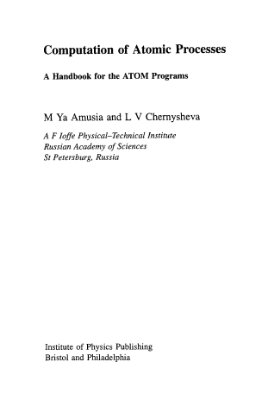IOP Publishing Ltd, London, 1997, 259 pp. - ISBN 0 7503 0229 1
This book describes numerical methods for the investigation of atomic electron shell structure and the interaction between atomic electrons and various scattered particles, such as electrons, positrons, photons and muons. There are two reasons why these problems are of interest to scientists. First, an atom is the basic element of various natural systems ranging from enormous, distant stars to the smallest biological and chemical units, i.e. molecules. The photons emitted by atoms are the source of very important, if not unique, information about the structure of various objects and the state of their substance. The spectrum of atomic radiation allows us to determine whether the atom is neutral or ionized and how many electrons are eliminated. Spectra and photoionization probabilities are a sort of signature which allow us to identify this or that kind of atom in a molecule or in the sample investigated. Secondly, the interaction between fluxes of different particles (including photons) and atoms is a widespread, natural process. Our planet and its atmosphere in particular is irradiated with fluxes of sunlight and charged particles and it is very important from the viewpoint of life itself to know how this radiation interacts with atmospheric atoms, what is the probability of such interactions, to what extent they have no effect, and to what extent radiation does induce ionization of atoms or molecules. Sometimes knowledge of these features is vital.
Contents
Preface
Overview
Essential Physics of the ATOM System
Mathematical Description of Atomic Properties
Radial Self-consistent Hartree-Fock-Dirac Equations
Radial Hartree-Fock Equation for the Frozen Core
The Choice of Wavefunctions
Photoionization, Oscillator Strengths and Polarizability
Generalized Oscillator Strengths
Electron-impact Ionization
Generalized Oscillator Strengths with PCI
Inner-shell Photoionization with PCI
Near-threshold Ionization
Self-energy Part of the One-particle Green Function
Scattering Phases and Electron Wavefunctions Taking Account of the Self-energy Part
The Auger Decay Widths of Atomic Levels
Probability of Double Auger Decay
One-photon Decay of Two-hole States
Electron-induced Triplet Level Excitation
High-energy Projectile Bremsstrahlung
Intermediate-energy Bremsstrahlung
The Photoabsorption Cross-section
The Features of Muon Capture
The Structure of the ATOM System
Results of Calculations
References
Index
This book describes numerical methods for the investigation of atomic electron shell structure and the interaction between atomic electrons and various scattered particles, such as electrons, positrons, photons and muons. There are two reasons why these problems are of interest to scientists. First, an atom is the basic element of various natural systems ranging from enormous, distant stars to the smallest biological and chemical units, i.e. molecules. The photons emitted by atoms are the source of very important, if not unique, information about the structure of various objects and the state of their substance. The spectrum of atomic radiation allows us to determine whether the atom is neutral or ionized and how many electrons are eliminated. Spectra and photoionization probabilities are a sort of signature which allow us to identify this or that kind of atom in a molecule or in the sample investigated. Secondly, the interaction between fluxes of different particles (including photons) and atoms is a widespread, natural process. Our planet and its atmosphere in particular is irradiated with fluxes of sunlight and charged particles and it is very important from the viewpoint of life itself to know how this radiation interacts with atmospheric atoms, what is the probability of such interactions, to what extent they have no effect, and to what extent radiation does induce ionization of atoms or molecules. Sometimes knowledge of these features is vital.
Contents
Preface
Overview
Essential Physics of the ATOM System
Mathematical Description of Atomic Properties
Radial Self-consistent Hartree-Fock-Dirac Equations
Radial Hartree-Fock Equation for the Frozen Core
The Choice of Wavefunctions
Photoionization, Oscillator Strengths and Polarizability
Generalized Oscillator Strengths
Electron-impact Ionization
Generalized Oscillator Strengths with PCI
Inner-shell Photoionization with PCI
Near-threshold Ionization
Self-energy Part of the One-particle Green Function
Scattering Phases and Electron Wavefunctions Taking Account of the Self-energy Part
The Auger Decay Widths of Atomic Levels
Probability of Double Auger Decay
One-photon Decay of Two-hole States
Electron-induced Triplet Level Excitation
High-energy Projectile Bremsstrahlung
Intermediate-energy Bremsstrahlung
The Photoabsorption Cross-section
The Features of Muon Capture
The Structure of the ATOM System
Results of Calculations
References
Index

